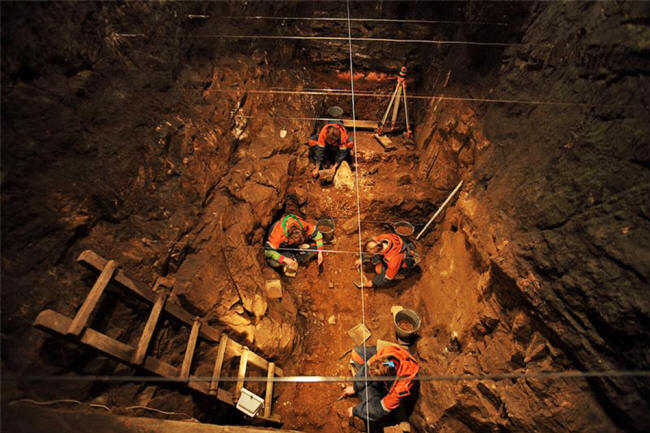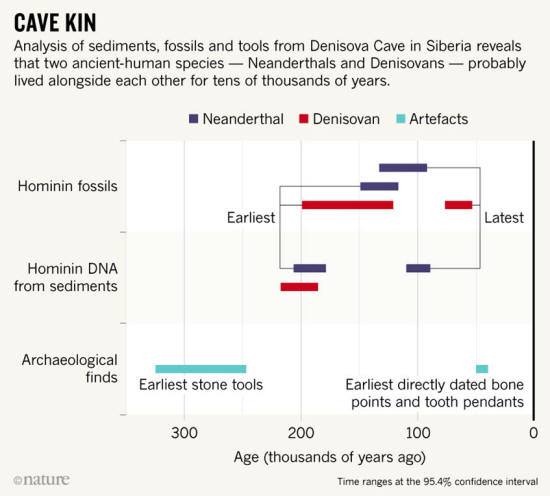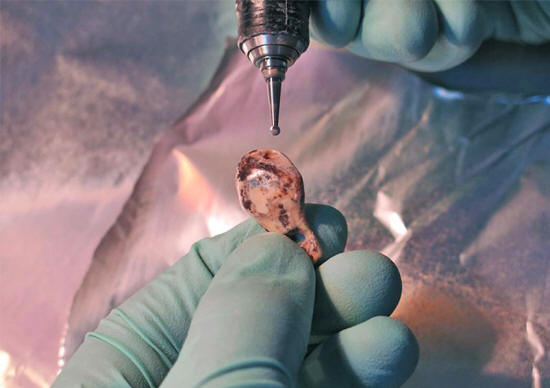|

by Ewen Callaway
January 30,
2019
from
Nature Website

Denisova cave in southern Siberia
has been a rich source of ancient-human remains.
Credit: IAET SB RAS
Neanderthals and Denisovans
both called
Denisova Cave home
- and Homo
sapiens might have, too...
Neanderthals and Denisovans might have lived side by side for tens
of thousands of years, scientists report in two papers in Nature.
1,2
The long-awaited studies are based on the analysis of bones,
artifacts and sediments from Denisova Cave in southern Siberia,
which is dotted with ancient-human remains.
They provide the first
detailed history of the site's 300,000-year occupation by different
groups of ancient humans.
"We can now tell the
whole story of the entire cave, not just bits and pieces," says
Zenobia Jacobs, a geochronologist at the University of
Wollongong, Australia, who co-led one of the studies.
Ancient-human
hotspot
Soviet archaeologists began unraveling the story of Denisova Cave,
at the foot of the Altai Mountains, in the early 1980s.
Since then, scientists
have found the fragmentary remains of nearly a dozen ancient humans
at the site. The cave became world famous in 2010, after an analysis
of the DNA from a tiny hominin finger bone found that the creature
was distinct from both modern humans and Neanderthals. 3
It belonged to a
previously unknown hominin group, later named Denisovans.
Additional sequencing of the DNA in bone remains from the cave found
that Denisovans were a sister group to Neanderthals, and might once
have lived across Asia - where they interbred with the ancestors of
some humans now living there. 4
Last year, the site produced another
spectacular discovery:
DNA analysis of a
long bone fragment revealed the first ever known 'hybrid' of two
ancient-human groups, a woman - nicknamed Denny - whose mother
was a Neanderthal and father a Denisovan. 5

Dating tangle
Most of the cave's remains are older than the 50,000-year limit of
the radiocarbon dating technique that's used on organic materials,
and efforts to use other methods to date the sediments in which the
remains are buried have been hampered by the lack of a good map of
the cave's geological layers.
Many scientists worry
that disturbances in the cave, such as animal burrows, have
scrambled its contents such that remains and artifacts no longer sit
in sediments of similar age.
To surmount those challenges, researchers led by Jacobs and
Wollongong geochronologist Richard Roberts used a dating
technique that determines when individual grains of soil were last
exposed to light. 1
This allowed them to
identify regions of the cave in which the soil had been disturbed so
that adjacent grains returned wildly different dates. They could
then omit those areas when dating sediments in the same geological
layer as hominin remains and tools.
The first signs that any ancient-human species had occupied the cave
are stone tools - excavated beginning in the 1980s - that were dated
to around 300,000 years old (see 'Cave kin').
But the researchers could
not work out whether Denisovans or Neanderthals made them.
The cave's Denisovan
remains (including some DNA that leached into the soil) date to
between 200,000 years ago and 55,000 years ago, whereas the oldest
Neanderthal remains are around 190,000 years old and the youngest
date to some 100,000 years ago.
The researchers cannot find out precisely when the groups lived
together, or whether they ever shared the cave.
But the existence of the
hybrid individual - who lived around 100,000 years ago - means that
the groups must have lived close enough to each other to meet at
that time.
Furthermore, Denny's
father harbored a sliver of Neanderthal ancestry, suggesting that
his ancestors had previously interbred with Neanderthals.

Bone pendants and tools
were
found in the cave's younger layers
and
date to between 49,000 and 43,000 years old.
Credit:
Tom Higham, Univ. Oxford
Who was here?
Homo sapiens might also have lived in the cave, the researchers
suggest.
Bone pendants and tools -
similar to those made by early modern humans in Europe - from the
cave's younger layers date to between 49,000 and 43,000 years old,
reports a team led by archaeologists Katerina Douka at the
Max Planck Institute for the Science of Human History in Jena,
Germany, and Tom Higham at the University of Oxford, UK, in
the second Nature paper. 2
The researchers dated one hominin bone to around 46,000-50,000 years
ago, but could not retrieve any DNA to investigate which species it
belonged to.
No other H. sapiens remains from this period, known as the Initial
Upper Palaeolithic, have been found in Denisova cave or the wider
Altai region.
For this reason, the
Russian archaeologists who spearhead the site's excavation have
argued that Denisovans made the artifacts, which are more
sophisticated than the site's older stone tools.
But Higham would like to
see more proof before linking the artifacts to any group.
"It's possible
Denisovans could have made the Upper Paleolithic. It's possible
the Russians are right. At the moment, with the evidence we
have, we can't really be sure," he says.
Hybrids similar to Denny
are another suspect, says Robin Dennell, an archaeologist at
the University of Exeter, UK, and author of an accompanying essay on
the studies. 6
It is also possible that whoever made the artifacts was influenced
by contact with H. sapiens, he says.
"I would be very
surprised if the Initial Upper Paleolithic at Denisova was made
by Denisovans or Neanderthals with no input from our species."
References
-
Jacobs, Z. et al.
Nature 565, 594–599 (2019) -
Timing of archaic hominin occupation
of Denisova Cave in southern Siberia
-
Douka, K. et al.
Nature 565, 640–644 (2019) -
Age estimates for hominin fossils and
the onset of the Upper Palaeolithic at Denisova Cave
-
Krause, J. et al.
Nature 464, 894–897 (2010) -
The complete mitochondrial DNA genome
of an unknown hominin from southern Siberia
-
Reich, D. et al.
Nature 468, 1053–1060 (2010) -
Genetic history of an archaic hominin
group from Denisova Cave in Siberia
-
Slon, V. et al.
Nature 561, 113–116 (2018) -
The genome of the offspring of a
Neanderthal mother and a Denisovan father
-
Dennell, R.
Nature 565, 571–572 (2019) -
Dating of hominin discoveries at
Denisova
| 



